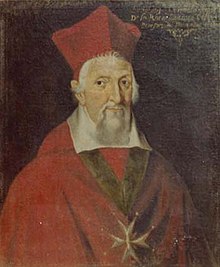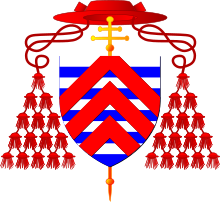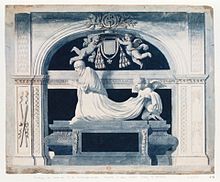François de La Rochefoucauld (Cardinal)
François de La Rochefoucauld (born December 8, 1558 in Paris , † February 14, 1645 there ) was a French prelate . He was Commendatarabbot of Saint-Philibert in Tournus and Saint-Mesmin de Micy , Bishop of Clermont and Bishop of Senlis , Grand Almosenier of France and cardinal from 1607 . He was one of the promoters of the reforms initiated by the Council of Trent in the Catholic Church in France .
Life
Youth and education

François was the son of Charles de La Rochefoucauld , Count of Randan, and Fulvia Pico della Mirandola . He lost his father at the age of four in the siege of Rouen in 1562 and was then entrusted to his uncle Jean de La Rochefoucauld , Abbot of Marmoutier . He completed his training with the Jesuits at the Collège de Clermont (today's Lycée Louis-le-Grand ) in the subjects of philosophy and theology.
In 1575 - he was 17 years old - the Cardinal de Lorraine made him Commander Abbot of Saint-Philibert in Tournus. In 1584 he followed his uncle as "Maître de la Chapelle" of the king. He returned from a subsequent trip to Italy with a rich collection of Greek and Latin works of art. King Henry III appointed him bishop of Clermont in 1585, he was ordained priest on September 27 of the same year . On October 6, 1585, Girolamo Ragazzoni , Bishop of Bergamo and Nuncio in France, gave him episcopal ordination ; Co- consecrators were Nicolas Fumeé , Bishop of Beauvais , and Antoine de Couppe, Bishop of Sisteron .
Adviser to Henry IV.
During the struggle for the succession he kept aloof, on the other hand he did not recognize King Henry IV until he converted to Catholicism on July 25, 1593 . Despite this hesitation, Heinrich appointed him commander in the Order of the Holy Spirit and in 1598 gave him the Abbey of Saint-Mesmin. As a proponent of the reforms that were suggested by the Council of Trent (1542–1545) also in the French clergy, he gained great influence in the episcopate of the country. Henry IV, who also saw him as a role model for the clergy, asked Pope Paul V to make La Rochefoucauld a cardinal. The Pope complied with the request on September 10, 1607. On March 15, 1610, Henry IV made him Bishop of Senlis and also appointed him his ambassador to the Holy See . As a cardinal priest he was assigned the titular church of San Callisto in the same year . He was also appointed vice-doyen of the college of cardinals . After three years in Rome, he returned to France in 1613.
Under Louis XIII.
On October 2, 1614, he took part in that lit de justice , the coming of age of King Louis XIII. explained. At the General Estates of 1614/15 he succeeded in getting the general assembly of the clergy to accept the decisions of the Council of Trent - with a few exceptions concerning the freedoms of the Gallican Church , whose representative La Rochefoucauld had already seen himself as a representative during his time in Rome. In 1618, after the death of Cardinal Jacques-Davy Duperron , he succeeded him as the king's grand almsman.
In the spring of 1619 he took part with Philippe de Béthune and Pierre de Bérulle in the negotiations that led to Louis XIII. and his mother, Maria de 'Medici , who fled to Angoulême to the Duke of Épernon , were reconciled (April 30, 1619). After the death of Benjamin de Brichanteau , Bishop of Laon , in the autumn of 1619, he became Commander Abbot of the Abbey of Sainte-Geneviève .
On April 8, 1622, Gregory XV commissioned him . by a papal bull with the supervision of the monastic reform in France, which resulted in the establishment of the Congrégation de France . He made the Abbey of Sainte-Geneviève the center of the congregation, which became his tool for the implementation of the Tridentine resolutions in the French monasteries.
As abbot of Sainte-Geneviève, he resigned to give the monks the opportunity to choose their monastery head themselves. On September 19, 1622 he resigned as Bishop of Senlis and in 1624 as President of the Council of State, which he had been since 1622 in order to devote himself entirely to monastic reform.
François de La Rochefoucauld died on February 14, 1645 at the age of 86 in the Abbey of Sainte-Geneviève , where he was also buried. In 1645 the painter Claude Vignon created a series of 30 pictures for the funeral ceremony of the cardinal.
Works
- De l'authorité de l'Église, en ce qui concerne la foi et la religion. Pillehotte, Lyon 1597.
- De l'estat ecclésiastique. Pillehotte, Lyon 1597.
- De la perfection de la hiérarchie ecclésiastique et quelle doit estre la vie, doctrine et soins nécessaires aux pasteurs de l'Église. Hénault, Paris 1628.
literature
- Gabriel de La Rochefoucauld: Un homme d'Église et d'État au commencement du XVIIe siècle. Le Cardinal François de la Rochefoucauld. Plon, Paris 1926.
Web links
- La Rochefoucald, François de. In: Salvador Miranda : The Cardinals of the Holy Roman Church. ( Florida International University website), accessed November 5, 2016.
- Entry on François de La Rochefoucauld on catholic-hierarchy.org ; Retrieved November 5, 2016.
Remarks
- ↑ from the cycle that Maria de 'Medici commissioned in 1620 for one of the two galleries in the Palais du Luxembourg to illustrate her life, and which was executed from 1621 to 1625
| personal data | |
|---|---|
| SURNAME | La Rochefoucauld, François de |
| BRIEF DESCRIPTION | Catholic bishop and cardinal |
| DATE OF BIRTH | December 8, 1558 |
| PLACE OF BIRTH | Paris |
| DATE OF DEATH | February 14, 1645 |
| Place of death | Paris |


